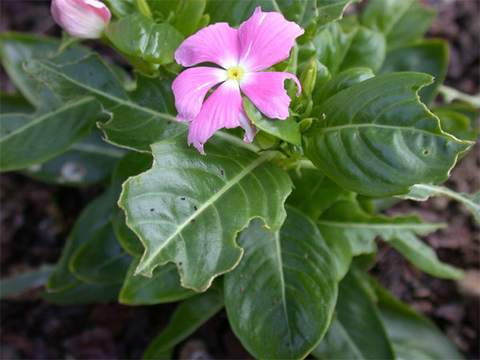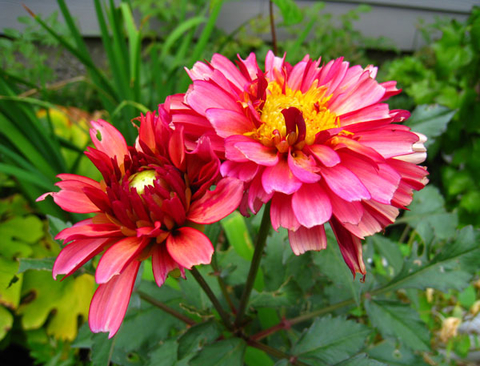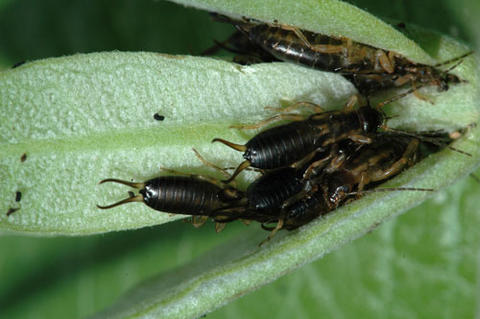Quick facts
Earwigs are a problem only during summer. They are most active at night and hide during the day in dark, confined, damp areas.
- They can enter homes and other buildings, sometimes in large numbers.
- They do not cause damage to people, property or food and are only a nuisance.
- They can chew irregular holes in leaves and flower blossoms of marigolds, dahlias, butterfly bush and hostas.
European earwigs are originally from Europe and were first noticed in Minnesota in the early 1990s.
How to identify earwigs
- Earwigs are about 5/8 inch long, with a flat, reddish brown body and very short wings.
- They have medium length antennae and chewing mouthparts.
- They have a pair of strong pinchers (cerci) on the tip of their abdomen.
- Males have stout, strongly curved cerci that are widely separated at the base.
- Females possess slender, straight pinchers that are close together.
Earwigs use their pinchers to protect themselves and to grab and hold prey.
- Nymphs are similar to adults but are smaller.
- Immature earwigs have slender, straight cerci.
- Young earwigs are generally lighter in color than adults.
Behavior and habits of earwigs
Earwigs can be found under potted plants, leaves, welcome mats and other objects. They are also seen in cracks between pavers, bricks and similar places.
- You can also find them on plants in buds and folded leaves.
- Earwigs are scavengers feeding on damaged and decaying plant matter.
- They can feed on weakened or dead insects and other small organisms.
- Earwigs can also feed on healthy plant material.
Earwigs mate in the fall and males and females usually spend the winter together in specially constructed nests. In early spring, females force the males out and then lay eggs.
- Female earwigs are very maternal, which is unusual for insects.
- They guard and protect their eggs and newly hatched young.
- Eggs hatch in about a week.
- Earwig nymphs emerge from nests sometime from late May to early June.
- They mature into adults in late June or early July and are active through fall.
Damage caused by earwigs
Earwigs as a household nuisance
Earwigs can enter homes and other buildings during summer (July and August), sometimes in large numbers. They may also be seen at other times of the year.
- They do not cause damage to people, property or food.
- They do not reproduce indoors and are only nuisances.
Earwigs cannot use their pincers to attack. They are harmless to people.
- They can grab onto objects with their pincers, but cannot squeeze very hard.
- Earwigs can give off a foul odor due to the liquid released from their abdomen.
An individual earwig does not live long indoors. Earwigs can continue to enter buildings throughout the summer.
Earwigs as a garden pest
Earwigs feed on a variety of vegetables and flowers and are active from late June to October.
- They chew irregular holes in leaves and flower blossoms of marigolds, dahlias, butterfly bush and hostas.
- They can attack corn silk and seedlings.
- Larger plants can tolerate this feeding.
- Large number of earwigs can damage or even kill seedlings and flowering plants.
- Earwig feeding may look like slug feeding. Slugs leave a slime trail but earwigs do not.
- Earwig damage can also be confused with cutworm and even rabbit feeding.
To find out which pest is causing the damage, use a flashlight to check under plants, at night.
How to get rid of earwigs
Some steps can be taken to reduce earwig numbers in your home and garden. But, when earwig numbers are high, you might have earwig problems even after taking these steps.
Keep your home and garden clean
- Clean up debris that earwigs can hide under, such as leaves, plant debris, bricks, piles of lumber and similar things.
- Thin out or remove mulch.
Trapping earwigs
You can set out rolled up newspapers or similar objects to trap earwigs.
- Place old tuna fish cans baited with fish oil or vegetable oil.
- Set them out during evening in areas where you have noticed earwigs in your garden.
- In the morning, shake the traps above a pail of soapy water to remove and kill the insects.
Excess moisture attracts earwigs
- Minimize excess moisture in the landscape.
- Be sure that the landscape has good drainage and that irrigation systems are working properly.
- Water more thoroughly and deeply but less often so the surface of the soil remains drier.
Seal any points of entry
- Caulk and repair any obvious spaces, cracks or gaps around the outside of your home at ground level.
- Pay special attention to areas around doors and windows and the juncture of the siding and the foundation.
- Also, watch around water faucets and vents.
Even with these steps, some earwigs can still get inside your home. If you see any earwigs inside your home, remove them with a vacuum or a broom and dust pan.
Using pesticides
You can supplement the above non-chemical steps with a pesticide treatment.
To prevent entry inside homes
- Use a residual insecticide, such as permethrin or cyfluthrin, around the foundation of the building.
- Once earwigs are indoors, pesticides are not effective.
Using pesticides in the garden
You can protect plants with a pesticide application.
- Treat the surrounding mulch where the earwigs are hiding.
- Use a drench, like lambda cyhalothrin, for this. You may need to attach the product to a hose to get sufficient volume.
- You can also use a bait, such as carbaryl, scattered on the ground around the plants you are protecting.
- Apply a pesticide spray of any of the below products, to protect individual plants when damage is first noticed.
- Permethrin
- Deltamethrin
- Acetamiprid
- Carbaryl
- You can use a permethrin or deltamethrin dust too.
CAUTION: Mention of a pesticide or use of a pesticide label is for educational purposes only. Always follow the pesticide label directions attached to the pesticide container you are using. Remember, the label is the law.
Reviewed in 2019






